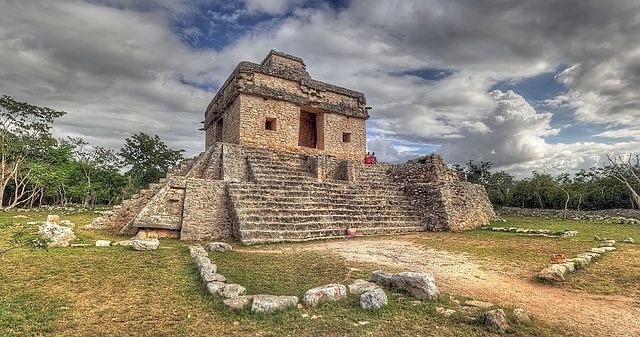Komchen is an ancient Mayan site located in the northern Yucatan Peninsula of Mexico. It’s known for its significant archaeological remains, which provide insights into the Preclassic period of Mayan history. The site features a range of structures, including residential complexes, ceremonial platforms, and a dense concentration of habitation remains. Komchen serves as a crucial piece in understanding the development of Mayan civilization and its early urbanization processes.
Get your dose of History via Email
Historical Background of Komchen
Archaeologists discovered Komchen in the 20th century, revealing its historical significance. The Mayans built this site during the Preclassic period, which dates back to around 300 BC. It later became a part of the larger cultural region known as the Puuc zone. Komchen’s inhabitants thrived for centuries before the site was abandoned, which is a common narrative among many Mayan cities. The reasons for this abandonment are still under study, with theories ranging from environmental changes to social upheavals.
John S. Henderson and Bruce H. Dahlin were among the first to conduct extensive research at Komchen in the 1980s. They uncovered evidence of extensive trade networks, agricultural practices, and social organization. The site was not just a local hub but also a player in the broader Mayan world. Komchen’s strategic location allowed it to control trade routes and resources, contributing to its growth and complexity.
After the initial settlement period, Komchen saw a significant increase in construction and urban development. This included the building of ceremonial centers and the expansion of residential areas. The site’s layout suggests a well-organized society with a clear understanding of urban planning. Komchen’s growth mirrors the broader trends of Mayan civilization during the Preclassic period, marking a transition from simple village life to more complex urban societies.
Despite its abandonment, Komchen was not forgotten. The site was later inhabited during the Classic period, although on a much smaller scale. This secondary occupation indicates that Komchen retained some level of importance within the Mayan cultural memory. The site’s structures and artifacts continued to influence the surrounding region long after its peak.
Komchen’s history is not marked by any single historically important event but rather by its role in the everyday lives of the Mayans. It provides a window into the daily activities, religious practices, and social structures of an ancient civilization. The site’s remains tell a story of human ingenuity, adaptability, and the complex web of interactions that defined the ancient Mayan world.
About Komchen
Komchen is characterized by its architectural features, which include residential complexes and ceremonial platforms. The site’s buildings were constructed using local limestone, a common building material for Mayan architecture. The structures at Komchen display the typical Mayan architectural elements such as corbelled vaults and intricate stone carvings.
The residential areas of Komchen are particularly noteworthy. They provide evidence of the social stratification within Mayan society. Larger, more elaborate buildings likely housed the elite, while smaller, simpler structures were home to the common people. The presence of these different residential areas indicates a complex community with a diverse population.
Ceremonial platforms at Komchen suggest that the site had religious significance. These platforms likely served as the foundation for temples and other religious structures. The Mayans used these areas for various ceremonies and rituals, which were integral to their culture and belief systems.
One of the most intriguing aspects of Komchen is its water management system. The Mayans engineered an extensive network of cisterns, known as chultuns, to collect and store rainwater. This system was crucial for survival in the arid Yucatan climate and demonstrates the Mayans’ advanced understanding of engineering and environmental adaptation.
The layout of Komchen reveals a planned urban environment. The site’s design includes a central axis, around which the main buildings are organized. This suggests a deliberate effort to create a cohesive and functional cityscape, reflecting the Mayans’ sophisticated approach to urban planning and design.
Theories and Interpretations
Several theories exist about the use and significance of Komchen. Some suggest that it was primarily a trade center, given its strategic location and evidence of extensive exchange networks. Others believe that Komchen was an agricultural hub, with its large population requiring a robust system to support food production and distribution.
The mysteries of Komchen include the reasons behind its abandonment. While some attribute it to environmental factors such as drought, others point to internal social conflicts or shifts in trade routes. The exact cause remains a topic of debate among scholars.
Interpretations of Komchen’s artifacts and structures often rely on comparisons with other Mayan sites. By matching architectural styles and pottery designs, researchers can piece together a broader picture of the Mayan civilization during the Preclassic period. This comparative approach helps to fill in the gaps where historical records are lacking.
Dating of Komchen has been carried out using methods such as radiocarbon dating and ceramic typology. These techniques have helped establish a timeline for the site’s occupation and development. They also provide a chronological framework for understanding the evolution of Mayan society in the region.
The interpretations of Komchen continue to evolve as new discoveries are made. Ongoing archaeological work contributes to a deeper understanding of the site’s role in Mayan history. Each new finding adds another layer to the complex story of this ancient civilization.
At a glance
- Country: Mexico
- Civilization: Maya
- Age: Preclassic period, circa 300 BC

